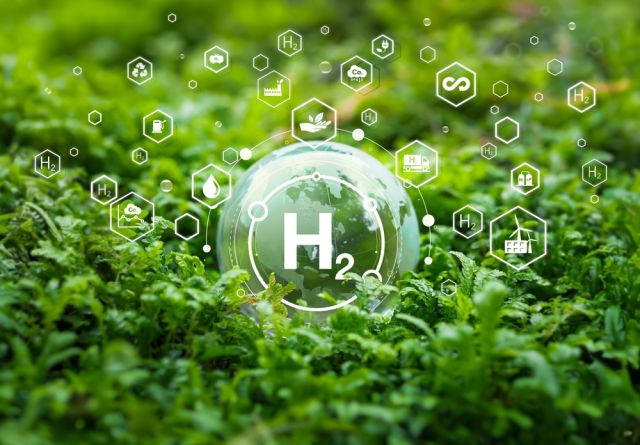
Hydrogen is mostly used today for oil refining, production of ammonia and as an ingredient for fertilizer. However, it has the potential to decarbonize hard-to-abate sectors such as steel, maritime and aviation. (Source: Shutterstock)
The Appalachian region is known for its abundant natural gas resources, but CNX Resources Corp. and others aim to establish the area as one of the first hydrogen hubs in the U.S.
“Since this is a hockey town, as a company, we feel like we need to be where the puck is going to be rather than where the puck is,” Navneet Behl, COO for CNX Resources, said recently at Hart Energy’s DUG East conference in Pittsburgh. “And that’s why we are really bullish on the hydrogen economy that’s coming here.”
Serving as an anchor supplier of low-carbon intensity feedstock, natural gas producer CNX is among the 15 key project development partners involved in the Appalachian Regional Clean Hydrogen (ARCH2) project. The hub was one of seven selected by the U.S. Department of Energy in October to enter negotiations—currently underway—for a share of up to $7 billion to form regional hydrogen hubs to jumpstart the sector in the U.S.
ARCH2, with applied science and tech company Battelle as program manager, is in line to get up to $925 million in federal funds. Private investment required for the hub is about six times as much, Behl said, adding the hub could bring more than $6 billion in investment to the region.
RELATED
CNX Banking on Built-in Customer Base for Hydrogen [WATCH]
US Unveils Recipients of $7 Billion for Hydrogen Hubs
Biden Spotlights $7B for Hydrogen Hubs, But Hurdles Remain
Hydrogen is mostly used today for oil refining, production of ammonia and as an ingredient for fertilizer. However, it has the potential to decarbonize hard-to-abate sectors such as steel, maritime and aviation; power fuel cells; generate electricity; and serve as a transportation fuel, displacing carbon-emitting fossil fuels.
Combined, the hubs are targeting production of more than 3 million metric tons per year (mtpy) of hydrogen, including electrolytic hydrogen (green) and hydrogen that uses natural gas as a feedstock with carbon capture (blue). ARCH2, which will span several sites across Ohio, Pennsylvania and West Virginia, is among the blue hydrogen hubs.
“If you look at the hydrogen value chain, the Appalachian region has all the ingredients of the value chain,” Behl said, referring to the region’s abundant, low-cost source of natural gas from the Marcellus and Utica shales, an industrial presence and capable workforce and hydrogen consumers. Plus, “within one hour of where we are in Appalachia, you have access to 50% of the country’s population.”
Providing feedstock
CNX will be the feedstock provider for Adams Fork, a proposed multibillion-dollar ARCH2 anchor project expected to produce up to about 2.1 mtpy of ammonia in its first train. That’s equivalent to more than 300,000 metric tons of hydrogen annually, according to the project’s website. The joint development of Adams Fork Energy LLC and the Flandreau Santee Sioux Tribe is located in Mingo County, West Virginia.
“We really believe [in] the federal government’s vision of creating this hydrogen economy to diversify our energy sources,” Behl said, later speaking to the hydrogen business case for CNX. “There’s going to be a natural transition from our current energy sources into future energy sources, and we believe [the] hydrogen economy is one of the key future energy sources. So, we want to be involved with that. … This will be the next phase of development for us as well, so we can grow as energy transitions and different forms of energy are developed and serve the communities going forward.”
However, it will be a while before the ARCH2 hub—along with the six others—becomes a reality.
Based on the DOE’s timeline, the hubs won’t begin operations for at least another seven years. Following negotiations and award announcements, project implementation will begin. The process has four phases: detailed plan; project development; install, integrate and construct; and ramp-up and operate.

“I think they’ve got an aggressive timeline,” Baker Botts partner Travis Wofford told Hart in a separate interview. But the process might take longer than expected, given the number of stakeholders involved, it being an election year and yet-to-come guidance on regulations and tax credits, he added.
Awaiting guidance
With offtake and demand still of concern for the nascent hydrogen industry, many companies are counting on tax credits such as 45V, introduced in the Inflation Reduction Act, to strengthen the economics of hydrogen projects.
“Guidance on 45V will be one of the key things that will help everyone invest more,” Behl said.
The 45V hydrogen production tax credit offers up to $3 per kg of hydrogen, depending on greenhouse-gas emissions intensity. But the industry still awaits guidance from the U.S. Treasury Department on what electricity power sources qualifies for the credit.
Stricter rules could favor green hydrogen production, which utilizes renewables such as wind and solar, in an effort to lower emissions; while looser rules could allow the sector to scale more quickly with the use of natural gas combined with carbon capture.
“That [45V] is going to be a large part of what determines the economics of some of these projects,” Wofford said, adding government support will be needed at not just the federal level but the state and local levels, plus commitments from high credit quality offtakers.
“Some of the questions that people are raising are, ‘to what extent is it going to be just hydrogen [produced], or will we focus on hydrogen and ammonia?’ Some of those decisions still need to be made,” Wofford said. “Ammonia can really accelerate the bankability of facilities so that it’s no longer just a local hydrogen economy that you’re focused on, but something that can allow export-import as well.”
Located on a reclaimed coal mining site near Gilbert Creek, West Virginia, the Adams Fork project could become the largest clean ammonia facility in the U.S., according to CNX. Construction is expected to begin in 2024.
Recommended Reading
AI Poised to Break Out of its Oilfield Niche
2024-04-11 - At the AI in Oil & Gas Conference in Houston, experts talked up the benefits artificial intelligence can provide to the downstream, midstream and upstream sectors, while assuring the audience humans will still run the show.
Betting on the Future: Chevron Technology Ventures’ Investment Strategy
2024-04-09 - After a quarter century, Chevron Technology Ventures seeks both incremental and breakthrough technologies with its early-stage investment program.
2023-2025 Subsea Tieback Round-Up
2024-02-06 - Here's a look at subsea tieback projects across the globe. The first in a two-part series, this report highlights some of the subsea tiebacks scheduled to be online by 2025.
Tech Trends: QYSEA’s Artificially Intelligent Underwater Additions
2024-02-13 - Using their AI underwater image filtering algorithm, the QYSEA AI Diver Tracking allows the FIFISH ROV to identify a diver's movements and conducts real-time automatic analysis.
Subsea Tieback Round-Up, 2026 and Beyond
2024-02-13 - The second in a two-part series, this report on subsea tiebacks looks at some of the projects around the world scheduled to come online in 2026 or later.






